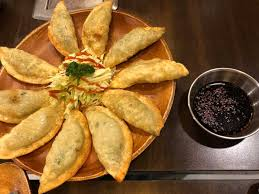
Mandu is made by filling a thin round flour skin with ground vegetables, meat, and other stuffing, then sealing its edges. It can be fried, steamed, or boiled, and is usually served at ancestral rites, feastings, or winter periods. Over time, Koreans have invented many variations of this dumpling.
Historically, Mongolians are thought to have been the ones who first brought mandu to Korea in the 14th century, the time of the Goryeo Dynasty. These people inhabited most of what is now called North Korea, thus resulting in war. Because the battle between the Mongolians and the Koreans lasted for such a long time, the two cultures started to merge. Lots of Mongolians married Korean royalties, which lead to the fusion of their traditions and habits.
During the said dynasty, the state of religion was Buddhism, which prohibits the consumption of meat. But Mongolian invasion into Goryeo put an end to the religious forbiddance by introducing mandu to the locals. Considering that Mongolians inhabited much of China in that era, this mandu is most probably a variation of that Chinese mantou. The dish initially settled within the region, the former capital of Goryeo, and rapidly expanded until it became very famous.
Another theory people believed to have been the origination of mandu is that this dish came to Korea much earlier than the 14th century coming from the Middle East through the Silk Road. This story implies that the mandu is a version of the Turkish manti. Historians specified that many cuisines made of wheat like dumplings and noodles developed from Mesopotamia and steadily extended from there. It also stretched east along the Silk Road, producing many renditions of mandu all over Central and East Asia.
Furthermore, when talking about the origin of this Korean dumpling, the earliest documentary evidence is a well-known folk song titled "Ssanghwajeom" which means dumpling shop. Written during the Joseon Dynasty in 1392, this piece details how a group of Uighurs arrived and established mandu stores.
Despite how mandu came to existent and where it came from, this Korean dumpling has taken over today's restaurants not only in Korea but in other countries around the world.









